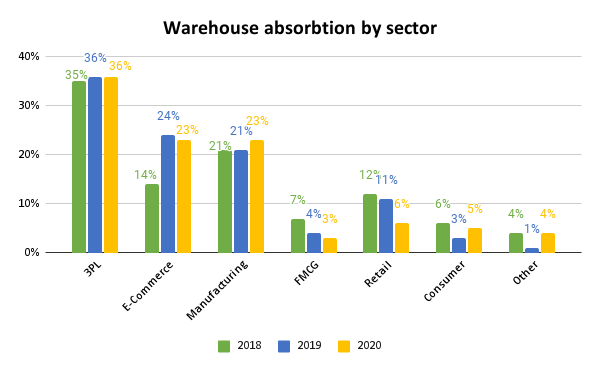Smart warehousing: A pressing priority for post-COVID businesses
From increased warehouse throughput to better resource utilization, reduced labor and operational costs to improved customer service, reduced handling and storage costs & minimized errors, smart warehousing provides benefits galore to those who catch the bus in time.
-
- Critical global trends are shaping the way the warehousing industry is competing worldwide. From technological innovation to smarter processes & systems, overarching transformation is enabling the warehousing industry to continue providing greater value.
- Integral technologies have also enabled for full tracking of all assets within the warehouse, thanks to key supply chain and logistics trends.
- India is expected to attract US$ 10 billion in storage and logistics investment in the next few years, fuelling demand for smart assets.
- The Indian Warehouse Automation Market is expected to develop at a 26.4% CAGR during 2021-2026, from US$ 86.2 million in 2020 to US$ 512.2 million in 2026.

Source: Shutterstock
Artificial intelligence is changing the technological paradigm in the warehousing business. The power of AI is fundamentally improving critical operations ranging from supply management to storage efficiency. Automation is enabling smart warehousing, which provides clients with higher efficiency by exploiting these modern logistics centers. It is the future of the market, with a wide range of industries embracing it for a variety of reasons, including cost savings, inventory adaptability, and real-time control. Automated warehousing is now being used by businesses to keep up with consumer requests and speed up shipping.
Emerging market and trends
Human errors are eliminated, and revenues have the potential to expand with the usage of AI. Thus, several warehouse and logistics operations are predicted to be totally automated by 2030. As AI grows increasingly prevalent, 30% of UK warehouse employment will be automated by that year. Predictable physical tasks (81%), data processing (69%), and data collection (69%) are the processes with the largest chances of automation (64 %).
Many of the world’s largest corporations are already implementing smart systems and warehouse automation technologies to improve efficiency. Here are a few such examples:
- Zappos, an online retailer that specialized in clothing and shoes, employs KIVA Systems at its Shepherdsville, Kentucky, center to construct a completely automated warehouse that allows them to retain free delivery and a 365-day return policy.
- Ocado, a British online grocer, employs highly automated warehouses with robots that unpack inventory, layout and stack shelves, and transfer items across the facilities.
- Amazon’s warehouses integrate AI technology and robotics to boost productivity, forecast and avoid problems in the customer journey, and develop bespoke platforms for the warehouse and online shop.
- Alibaba, a Chinese eCommerce retailer, employs a smart warehousing system in which robots do 70% of the work. Each robot also includes sensors to avoid collisions, and when their batteries run low, they autonomously transport themselves to a recharge station.
India’s warehouse automation market
The warehousing business in India, too, is experiencing a considerable transformation in order to keep up with the booming industrial sector and the enormous logistics business. The warehouse business is projected to gain significantly from the adoption of the goods and services tax and real estate investments. The Indian Warehouse Automation Market is estimated to grow at a CAGR of 26.4%, from US$ 86.2 million in 2020 to US$ 512.2 million in 2026.
With the expansion of India’s manufacturing, retail, and FMCG industries, there is an increased need for industrial automation solutions. Shuttle retrieval systems, automated storage, and mobile robot platforms are all booming. Robotics is increasingly important to the profitability of many end-users. The AMRs (Autonomous Mobile Robots), which are required for fast, secure, and error-free delivery, short time to market, lower costs, and end-to-end trackability, are leading the way.
In March 2020, Aurionpro Solutions Ltd, a supply chain solution provider known for its software services for cold storage, announced the onboarding of India-based cold chain service provider Coldrush Logistics to assist them in developing compliant warehouse procedures. Further, the trial project for robot-based sortation technology is being executed at Flipkart’s Soukya sortation facility in Bangalore. More than 100 self-guided robots will autonomously sort the items in the order of delivery pin codes as part of the overall arrangement. According to Flipkart’s first studies, every hundred AGVs (automated guided vehicles) result in a 60% boost in process efficiency.
Over the last decade, logistics and supply chain management have evolved from a cost center to a profit generating domain. As a result, many industries, including e-commerce and manufacturing, have begun to outsource a significant amount of their operations to storage firms. Thus, the desire for a more methodical approach aided by smart technology has grown even more.
With rising demand, supply chain management transparency is becoming increasingly important. This may be done by using automated technologies that are adaptable and contribute significantly to the dynamic supply chain while maintaining a client-focused, service-oriented attitude.
The market dynamics of warehouse management systems
- Increased expansion in the e-commerce business as a result of the COVID-19 pandemic:
Due to the implementation of social distance, lockdowns, and other measures in reaction to the COVID-19 epidemic, customers have turned to internet purchasing. With a considerable shift in customer purchasing behavior, there has been a rise in the installation of real-time warehouse management system software solutions for effective order processing, picking and shipping. Thus, many e-commerce firms started establishing in-city warehousing to reduce delivery times of perishable items as well as to avoid the movement restrictions.
- Multinational corporations are increasing their investment in emerging economies:
As a result of this expansion, innovative and complex warehouse facilities are required to connect and manage supply chain networks. The surge in new investments to improve emerging nation’s supply chain capabilities has created an enormous development potential for the warehouse management system industry. Therefore, quite a few states in India are offering incentives for developers interested in investing in warehouses and logistics parks such as single window and time-bound clearances, labour law flexibilities, power at a concessional rate and allotment of government land.

Source: Invest India
Thus, the employment of artificial intelligence in warehouse automation is no longer a pipe dream. It has already arrived. To accomplish automation, major businesses have already incorporated AI into their warehouse management systems. As a result, other organizations should consider how to include AI technologies into their warehouse in order to streamline their operations.
The real challenge, however, is that small-scale enterprises are not aware of the benefits of warehouse management system. Due to the low yearly income of small-scale enterprises, expenditures to set up WMS appear to be a needless outlay for these business owners. Due to a reluctance to replace existing systems and constrained expansion plans, business owners in small-scale sectors fail to grasp the benefits of utilizing WMS.
However, they too can join the modern warehousing bandwagon by investing in a cloud-based warehouse management system that can be quickly and cost effectively rolled out across multiple sites. This model is not only intuitive and scalable, it can also be tailored to customer service innovations such as distributed order managing, waveless and priority based order processing and optimal returns processing.
Estimates suggest that users typically benefit from efficiency and productivity improvements up to 30%. Alternatively, they could start by investing in basic warehouse automation like a conveyor or carousel moves inventory from point A to point B (& save labour costs) and then move to more advanced versions. Thus, they can achieve more with the same resources and watch their productivity grow.
To sum up, while warehouse automation has significant upfront costs, it has many benefits that help enhance productivity in the long run. Thus, from increased warehouse throughput, better resource utilization, reduced labor and operational costs to improved customer service, reduced handling and storage costs & minimized errors, this trend provides benefits galore to those who catch the bus in time.













Leave a comment